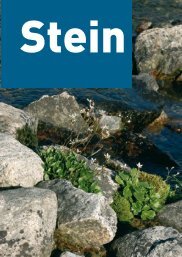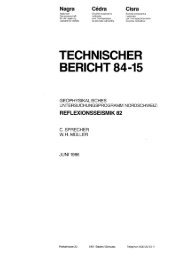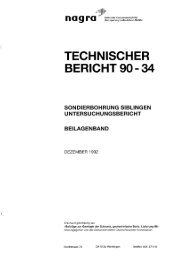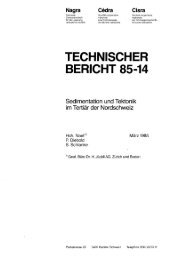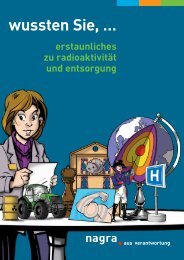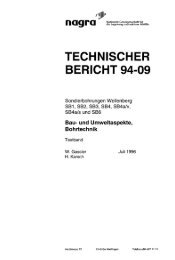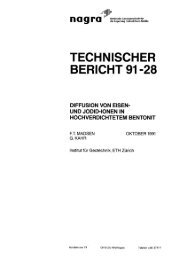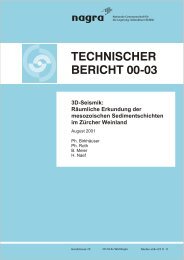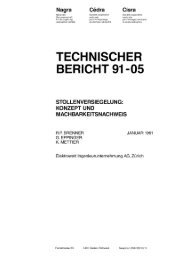Deutsch (27.2 MB) - Nagra
Deutsch (27.2 MB) - Nagra
Deutsch (27.2 MB) - Nagra
Erfolgreiche ePaper selbst erstellen
Machen Sie aus Ihren PDF Publikationen ein blätterbares Flipbook mit unserer einzigartigen Google optimierten e-Paper Software.
iotite-plagioclase-gneisses (partly hornblendebearing)<br />
with acidic dyke rocks. The latter make up<br />
around 18% of the drilled section in the Crystalline.<br />
The original material for the gneisses is assumed to<br />
be dolomitic claystones with a low aluminium content<br />
up to argillaceous to dolomitic graywackes<br />
which were subjected to overprinting by a regionalmetamorphism<br />
(amphibolite facies) with slight migmatization<br />
during the Caledonian orogeny.<br />
During the course of the Late Variscan-Upper Carboniferous<br />
movements and granite intrusions<br />
(around 300-320 Mio. years), the rocks at Weiach<br />
were partly subjected to intensive tectonohydrothermal<br />
overprinting. A combination of tectonic movement<br />
and convective circulation of a hot H20-NaCI<br />
fluid (possibly subject to local overpressures) led to<br />
marked cat aclasis and hydrothermal alterations. The<br />
metamorphic minerals were altered by the supply of<br />
H20 (± C02), involving mainly intergranular material<br />
exchange processes with conservation of overall rock<br />
chemistries. Ore-forming enrichment processes<br />
therefore did not occur. Alterations took place<br />
under retrograde conditions at temperatures below<br />
400°C and pressures below 1 kb. There must have<br />
been a strongly increased geothermal gradient which<br />
was probably caused by shallow intrusions in the<br />
environment.<br />
The calcite fractures, CaCh-rich fluid inclusions and<br />
Ca2 -+ - interlayer coatings of the layer silicates<br />
occurring in the Weiach Crystalline could all be evidence<br />
of Permian movements. Intensive Permian<br />
brittle deformation and breaking down into clay such<br />
as is found in the Crystalline of the Bottstein, Leuggem<br />
and Kaisten boreholes is not present in Weiach.<br />
Over 90% of the fractures are healed with new formations<br />
and contain mainly chlorite and calcite.<br />
Open fractures were observed only in the aplites.<br />
Sub-division into different fracture systems is not<br />
possible.<br />
Use of petrophysicallogs allowed a clear distinction<br />
to be drawn between gneisses and aplites, even in the<br />
bitted sections. However, further sub-division of the<br />
gneisses and clear identification of the structures<br />
present was not feasible.<br />
For both the Crystalline and the sediments, parameters<br />
such as composition of the clay minerals, rock<br />
chemistries (main- and trace elements), cation<br />
exchange capacity, rock and grain densities, specific<br />
surfaces and thermal conductivity were determined,<br />
the aim being, inter alia, to obtain base data on<br />
radionuclide retention in the rock.<br />
Borehole geophysics<br />
A comprehensive geophysical investigation programme<br />
was carried out in the Weiach borehole. The<br />
resulting data-set was compared with the results of<br />
drill-core analyses and tests carried out in the borehole.<br />
This allowed detailed information to be obtained<br />
even in sections with core-loss and in bitted sections.<br />
As expected, the petrophysical logs carried out by<br />
the Schlumberger company proved very suitable in<br />
the sediment section from the point of view of measuring<br />
the most important formation parameters "in<br />
situ".<br />
In addition a quantitative computer analysis using<br />
the @ GLOBAL programme was carried out in the<br />
sediments. This allowed identification of the rock<br />
formations drilled through, independent of the drillcores.<br />
It was also possible to make a volumetric analysis<br />
of the most important mineral components such<br />
as quartz, feldspar, calcite, dolomite, ankerite/siderite,<br />
anhydrite, iron ore and coal/tuffites, as<br />
well as of the porosity. The well-logging in the Crystalline<br />
is also sufficiently precise to allow recognition<br />
of qualitative features of the formations drilled<br />
through; quantitative interpretation is not possible<br />
since the specific composition of simultaneously<br />
occurring minerals and the effects of material migration<br />
and trace elements can not be calculated.<br />
Nevertheless, the lithology in the hitted sections<br />
could be determined satisfactorily using the<br />
@ LITHO-analysis.<br />
The orientation of the foliation and cleavage in the<br />
sediments was determined using log data obtained<br />
with the dipmeter probe. In the Crystalline the interpretation<br />
of the dipmeter log was possible only to a<br />
very limited extent since it is not always possible to<br />
distinguish the cleavage from cataclasites and schistosity<br />
planes.<br />
Borehole seismic and gravimetric measurements provided<br />
the basis for the recalibration of the sonic and<br />
density logs and allowed precise, reliable interpretation<br />
of the seismic reflection and gravimetric surface<br />
data.<br />
Evaluation of the geothermal data showed a correlation<br />
between thermal conductivity and seismic velocity,<br />
with a marked rise in the temperature curve in<br />
the vicinity of the "heat-accumulating" coal intercalations.<br />
The average geothermal gradient in Weiach<br />
can be taken as 41-46°C/km.



